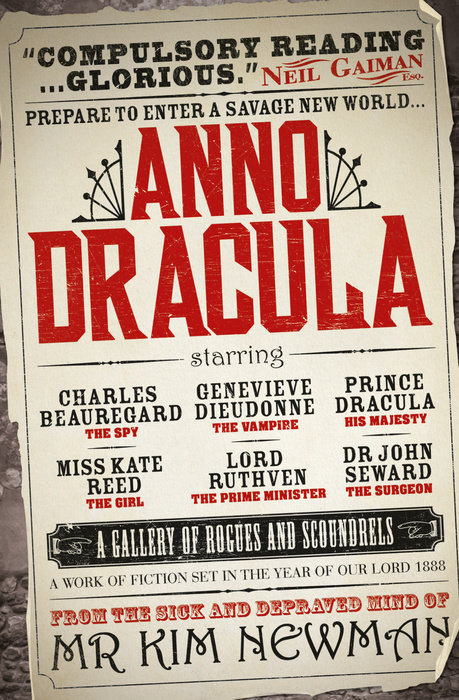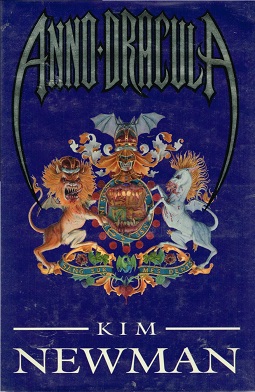If you want a guided tour through Gothic horror, read Anno Dracula by Kim Newman.
While many authors have been known to write alternate versions of classic novels, and even use recognizable literary and historical figures (Tim Powers, for instance, thrives on this), Newman’s dark, dystopian pulp-thriller goes even one step further. Not only is it a fascinatingly dense suspense novel awash in Gothic and Victorian pulp atmosphere, care is taken as to how each part of the terrifying, vampire-ruled England fits together. Sure, it’s a world where Jack the Ripper, Fu Manchu, and Lord Ruthven all exist in practically the same city, but it never feels weird or jarringn. Instead, Newman calls on his vast knowledge and experience as a horror scholar to add texture to the world, using the various characters old and new to examine tropes, add detail to the vibrant and dangerous version of London where the novel is set, and to create a towering work that explores, deconstructs, and celebrates Gothic horror all at once.

Anno Dracula stems from a simple enough premise: What if, at the end of Bram Stoker’s Dracula, Harker and Van Helsing and their various companions lost? In Newman’s version of events, Dracula successfully murders Van Helsing and then proceeds to wipe the floor with the would-be protectors of London, leaving them broken, dead, or turned. Once triumphant, he marries Queen Victoria, becomes Prince Consort and Lord Protector, mounts Van Helsing’s head on a spike outside the palace, and sets about remaking England in his own totalitarian image. Vampires run most forms of government, “the warm” are forced to either turn or live alongside a race that views them as food, and anyone who resists is either impaled without a trial or thrown into a prison camp. A serial murderer known as “the Silver Knife” stalks the streets, murdering vampire women. And in the midst of it all, the Diogenes Club, a secret agency of the former Crown, pairs one of its top agents and a vampire doctor to find the killer before the situation explodes. Behind the scenes, shadowy organizations threaten to push the city towards chaos for their own ends. London is primed to explode. But who is responsible, and more importantly, why?
With the stage set for a good Victorian noir conspiracy thriller, Newman’s other conceit is that to some extent, all fiction taking place during the time period, along with any fictional or historical characters who could exist in the setting during that time (with some changes here and there) are treated as real and existing. It’s sort of like a proto-League of Extraordinary Gentleman: Mycroft Holmes (brother of Sherlock) leads an underground conspiracy attempting to depose Dracula, The Invisible Man and Fu Manchu rub elbows with Professor Moriarty in the criminal underworld, Lord Godalming from Dracula is a vampire parliamentarian under the watchful eyes of Lord Ruthven from Polidori’s The Vampyre, Dr. Henry Jekyll handles death inquests, and the jiangshi from Hong Kong classic Mr. Vampire hops in to carry out a contract hit at one point. While it sounds like it would be cacophonous at best, Newman knows just exactly how to turn things slightly so they fit into the story. None of the actions of the literary figures used feel out of place, and they fit alongside their historical and invented brethren perfectly, making the world feel more of a piece and tying everything together in a tangible history.
What makes Anno Dracula so interesting isn’t just that all these figures are integrated well into Newman’s world, but that Newman has clearly given a lot of thought to how the world would work with all these bizarre and outsize events in it. There’s a sense of desperation when you realize that Sherlock Holmes has been put into a prison camp along the Thames and his nemesis Professor Moriarty has forged an uneasy alliance with the heroes. Hearing that Orlok, the bald and bestial vampire from Nosferatu is running the Tower of London adds a sense of tension to the location, as well as showing that even among vampires there’s a certain thread of discrimination and a need to keep their less savory elements out of sight and mind. It’s also an interesting way to discuss the Gothic fiction tropes at play in the text. Newman himself states that Sherlock Holmes was locked in a prison camp offscreen specifically because if you have Holmes in a story with Jack the Ripper, Holmes will immediately solve the murder on page two. Similarly, the idea that the “forces of good” or people who are “virtuous” will automatically win out is ruthlessly and gruesomely deconstructed not just in flashback, but in the text, as frequently honorable characters end up getting yanked around as pawns or thrown into awful situations at the whims of the higher powers who use that honor for their own gain. Similarly, Newman takes aim at the moral hypocrisy of the Victorians and the idea that their virtues hold any water or protection. The middle class readily embraces getting turned into blood-drinkers as a form of social climbing, and Dracula’s deeply twisted medieval morality turns deeply disturbing and fatal for multiple vampires when he decides to hold everyone to the same moral standard and dishes out impalings for crimes against his religion.

Even if you don’t recognize all the characters featured and invoked in the text (and that would take a lot of reading), they’re true enough to their world that you don’t necessarily have to know that, for example, Kostaki is the demonic brother from an Alexandre Dumas short story. The book is good enough that there’s no advance reading necessary to know who these people are outside the text. In fact, it can work in reverse–the newer editions of the book contain extensive notes and a media guide as part of the afterword, allowing readers to look up anything or anyone they found intriguing and get an excellent gateway into Gothic horror from the past all the way up to the modern day. Having these characters and their history in no way distracts from the book, but instead adds to it, and between that and the notes, it encourages the reader to seek out what might have interested them about the book. It’s also a gorgeous way into literary history, as it shows how the overlapping themes and ideas each of the works Newman included fit into the larger history of Gothic and Victorian works.
This might sound like a lot for a three hundred fifty page book, but rest assured, it’s well worth it. It’s a multilayered gothic noir, one that spawned an entire historical epic about a world where humans and vampires are forced to coexist. It’s a dark social satire, a literary mashup, a thrilling crime novel, and a guided history to the Gothic all in one tight, convenient package. But most of all, it’s a strange and wonderful blood-soaked work of horror, one by someone with a deep knowledge and abiding love of the genre.




Great summation. This is one of the books I point at when the question of what constitutes dark fantasy comes up.
There is a bevy of sequels to this book taking us through WWI (Bloody Red Baron), The 1950’s (Judgment of Tears/Dracula Cha Cha), The 70’s (Johnny Alucard) to recent (Daijaiju Anno Dracula 1999*)
*A sequel to a short story collection Anno Dracula 1899